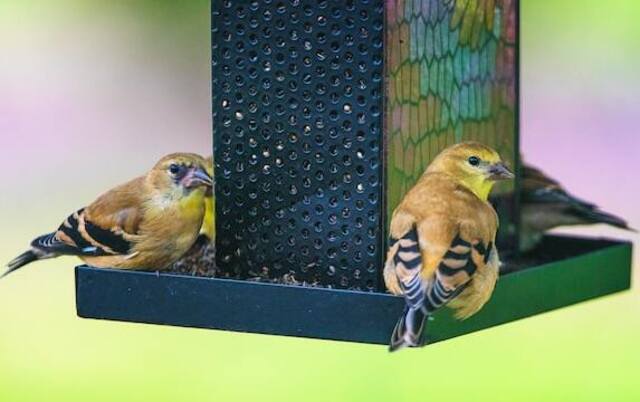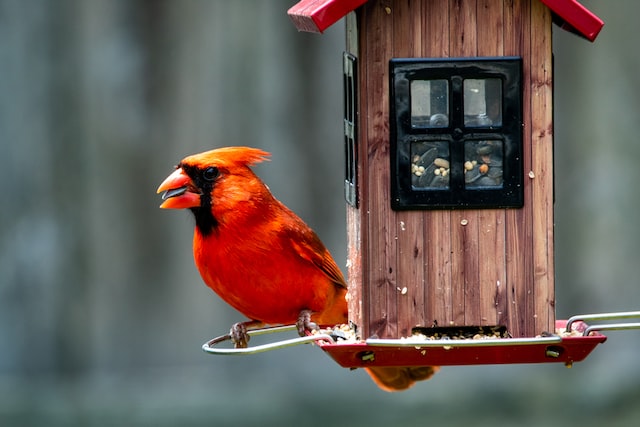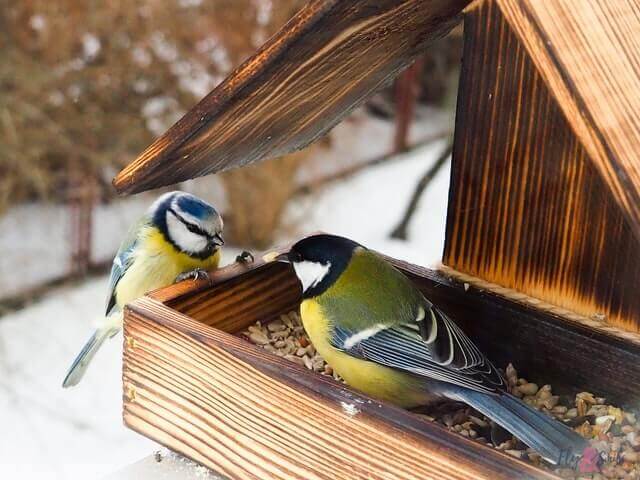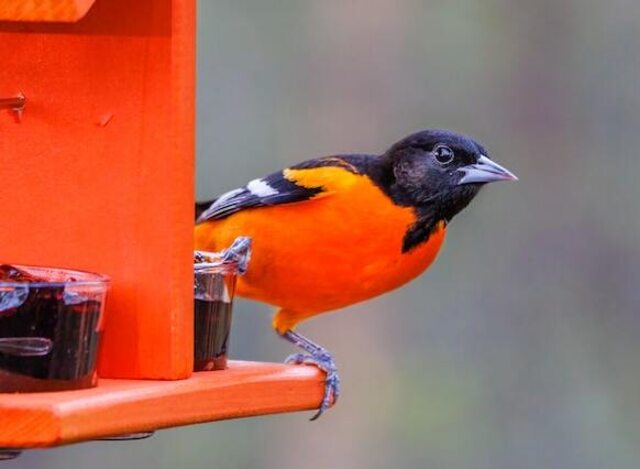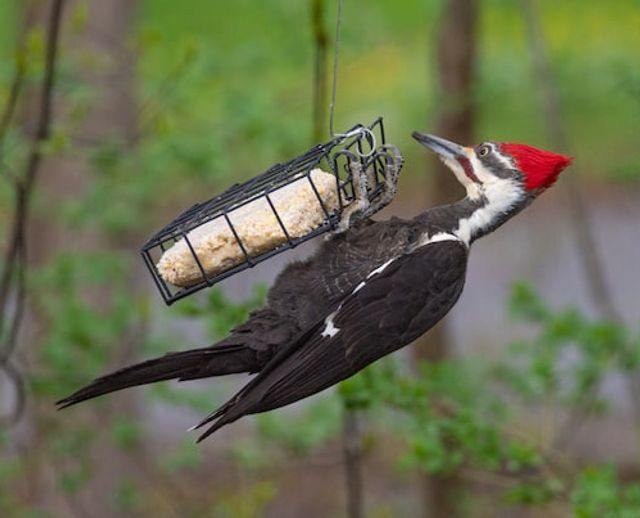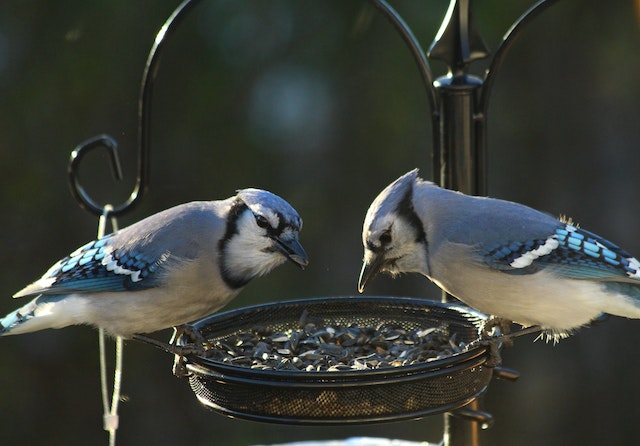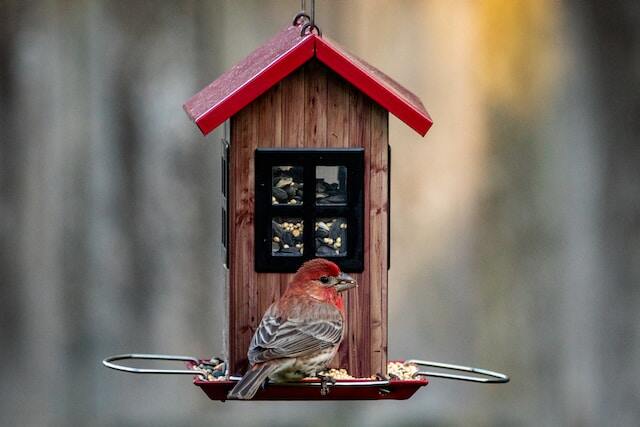Have you ever wondered How Long Does It Take For Birds To Find A Bird Feeder? Well, the short answer is, it depends. But don’t fly away just yet!
There are several factors that affect the time it takes for birds to discover your feeder, and we’re here to explore them all.
From the type of food you offer to the location of your feeder, we’ve got you covered. So, grab your binoculars and let’s take flight into the fascinating world of bird feeding!
Table of Contents
- 1 The Importance of Bird Feeders
- 2 Brief Overview of How Long It Takes for Birds to Find a Feeder
- 3 Feeding Birds: A Rewarding Experience
- 4 Factors that Affect How Long It Takes for Birds to Find a Feeder
- 5 Location of the Feeder
- 6 Type of Food Offered in the Feeder
- 7 Time of Year and Weather Conditions
- 8 Conclusion
- 9 FAQs: How Long Does It Take For Birds To Find A Bird Feeder?
- 9.1 How long does it take for birds to find a bird feeder?
- 9.2 How can I make my bird feeder more visible to birds?
- 9.3 What type of food should I offer in my bird feeder?
- 9.4 How often should I refill my bird feeder?
- 9.5 How can I keep squirrels away from my bird feeder?
- 9.6 Is it safe to use pesticides or insecticides around bird feeders?
- 9.7 How can I attract hummingbirds to my feeder?
- 9.8 Why are my bird feeders not attracting any birds?
- 9.9 Is it okay to feed birds in the winter?
- 9.10 How can I clean my bird feeder?
- 10 Author
The Importance of Bird Feeders
Bird feeders are an essential aspect of maintaining a healthy and diverse bird population in our environment. They provide supplemental nutrition to birds, especially during times when food is scarce.
Additionally, they offer the opportunity for birdwatching, which can be a relaxing and enjoyable hobby for many people.
Bird feeders also play a vital role in providing nesting areas for birds, leading to their protection and preservation.
In recent years, bird feeders have become increasingly popular among homeowners due to the joy they bring in attracting different species of birds to their yards.
However, it is crucial to understand that feeding birds requires responsibility as it involves their health and well-being.
Brief Overview of How Long It Takes for Birds to Find a Feeder
The time it takes for birds to find a feeder primarily depends on various factors such as location, type of food offered in the feeder, time of year, and weather conditions.
Typically, some species of birds may find your feeder within minutes while others may take days or weeks before showing up at your feeder.
It is important to bear in mind that there are no guarantees when it comes to how long until birds find your bird feeder.
However, patience and persistence along with proper planning and care for your feathered friends’ needs can increase the chances of attracting them more quickly.
Feeding Birds: A Rewarding Experience
Providing food through bird feeders can be a rewarding experience as it gives you an opportunity to observe interesting behaviors that would otherwise go unnoticed without close proximity to the birds.
It is also an excellent way to educate children about nature while fostering appreciation towards wildlife.
Understanding why feeding wild birds is important will help you appreciate their beauty while providing them with necessary nourishment.
Knowing how long it takes for birds to find a feeder is only the first step in creating a successful bird feeding station.
The following sections will explore the different factors that affect how long until birds find feeders and offer tips on ways to attract them quickly.
Factors that Affect How Long It Takes for Birds to Find a Feeder
Location of the feeder
The location of the bird feeder is one of the most important factors that affect how long it takes for birds to find it.
The location should be in a visible and accessible area, preferably near trees or bushes where birds can perch and feel safe while eating.
Avoid placing the feeder too close to windows or doors, as this can lead to accidents when birds fly into these structures. Another critical factor is ensuring that the bird feeder is not too high or low from the ground.
Hanging your bird feeder at eye level will make it easier for birds to spot and access it. If you have pets, ensure that they cannot reach the bird feeder because they may scare away birds or hunt them.
Type of food offered in the feeder
Different types of food attract different species of birds; therefore, offering a variety of foods can increase your chances of attracting a diverse range of species quickly.
Sunflower seeds attract many popular backyard birds such as finches, nuthatches, cardinals, grobeaks and chickadees. Nyjer seed attracts finches and siskins while suet cakes are ideal for woodpeckers.
It’s essential to keep your feeders clean and dry since moldy or spoiled food could harm migratory species that rely on feeders for energy during their long journeys.
Additionally, if one type of food is not working well in attracting local species, try switching out the food variety until you begin seeing more avian visitors.
Time of year and weather conditions
Weather conditions play an important role in determining how quickly birds will find your feeder as well as what types will visit.
During winter months when natural sources are scarce, different kinds such as juncos may appear sooner than others like warblers which migrate south.
In spring, hummingbirds may be attracted to red fuchsia flowers or sugar water in special feeders. Rainy days can affect how long it would take for birds to find your feeder since they prefer dry places and food.
On the other hand, it’s easier to attract birds on colder days when natural sources of food are scarce, making them more likely to visit your feeder. Choosing the right time of day is also important.
Mornings are an ideal feeding time as birds have yet to start their busy day of foraging for food elsewhere.
Avoid putting out fresh seed in the late afternoon or early evening as this signals mealtime and can attract wildlife that may not want to go away at night (such as raccoons).
| Factor | Description |
|---|---|
| Location of the feeder | Should be in a visible and accessible area, not too close to windows or doors, and not too high or low from the ground. |
| Type of food offered in feeder | Type of food offered in the feeder |
| Time of year | Weather conditions play an important role in determining how quickly birds will find your feeder as well as what types will visit. |
| Weather conditions | Rainy days can affect how long it would take for birds to find your feeder since they prefer dry places and food. |
| Time of day | Mornings are an ideal feeding time as birds have yet to start their busy day of foraging for food elsewhere. Avoid putting out fresh seed in the late afternoon or early evening. |
Location of the Feeder
Importance of placing the feeder in a visible location
One of the most important factors in attracting birds to your feeder is its visibility. Placing it in a visible location will not only make it easy for birds to find but also make it easier for you to watch them.
Birds are more likely to visit feeders that are easily visible, as they tend to gravitate towards spots where they feel safe and secure.
When choosing a location for your bird feeder, look for an area that is open and visible from multiple angles, such as near a window or on an open deck.
Avoid placing it too close to trees or bushes which can provide cover for predators like cats and squirrels.
Tips for choosing an optimal location for your bird feeder
The ideal location for your bird feeder should have some natural shelter nearby, like trees or shrubs. This will give birds a place to perch and rest while they feed, which can make them feel more secure and encourage them to return.
However, be careful not to place the feeder too close to these areas as predators may use them as hiding spots. Another factor to consider when choosing a location is the direction of sunlight.
Birds prefer feeding in areas with plenty of natural light so try and choose a spot that receives plenty of sunlight throughout the day. Consider how accessible the spot is when deciding on its placement.
Make sure you can easily refill the feeder without disturbing any nearby plants or structures, and try not to place it too high off the ground which would make maintenance more difficult.
By considering these factors when choosing where to place your bird feeder, you can create an environment that’s welcoming and attractive for local birds while also making it easier for you to watch their activities from inside your home or yard.
| Location of the Feeder | Importance of Placing the Feeder in a Visible Location |
|---|---|
| Visible location | Placing the feeder in a visible location is important as it makes it easier for birds to find and encourages them to visit frequently. Birds tend to visit feeders in visible areas where they feel safe and secure. Look for open areas visible from multiple angles. Avoid placing near trees or bushes that can provide cover for predators. |
| Optimal location tips | The ideal location should have nearby natural shelter, such as trees or shrubs, where birds can perch and feel secure. Ensure the feeder is not too close to hiding spots for predators. Choose a location that receives plenty of sunlight throughout the day and is easily accessible for refilling. Avoid placing the feeder too high off the ground. By considering these factors, you can create an environment that attracts local birds and is easy to maintain. |
Type of Food Offered in the Feeder
Overview of Different Types of Bird Food
Birds are known to vary in their food preferences. Some birds have a diet that consists mainly of insects, while others feed on fruits, seeds, or nectar.
Therefore, it is essential to know the types of food that different bird species prefer and offer them in your feeder. The most common types of food for birds include:
1. Seeds: Seeds are perhaps the most popular food type for many birds. Examples include sunflower seeds, safflower seeds, and millet.
2. Nectar: Nectar is a sweet liquid that hummingbirds love to feed on. If you plan on attracting hummingbirds, then you can offer them nectar by filling up a feeder with a sugar water solution.
3. Suet: Suet is a type of fat that provides high energy levels for birds during cold months when other food sources may be scarce.
4. Fruits: Many bird species enjoy eating fruits such as berries or apples.
Explanation on which type(s) are most attractive to birds
Different bird species have different preferences when it comes to feeding habits.
However, black oil sunflower seeds are perhaps the most attractive option for many backyard birds such as finches and sparrows due to their high-fat content and easy access to the seed kernel itself.
Other popular options include nyjer seed (often referred to as thistle), peanuts (for larger birds like woodpeckers), and suet cakes (best suited for insect-eating birds like woodpeckers).
It’s important also to consider local bird preferences – observing which types of backyard birds regularly visit your area will help guide what specific seeds or foods you should offer in your feeder.
Tips on How to Choose and Offer Food That Will Attract Birds Quickly
1. Variety is key: Offer a mix of different types of food to attract a variety of bird species.
2. Pay attention to the season: Different food sources may be more or less attractive to birds depending on the time of year, weather conditions, and migration patterns.
3. Keep your feeder fresh: Replace old seed or nectar regularly using clean feeders, as stale or moldy food can discourage feathered visitors.
4. Offer foods that appeal to specific species: If you want to attract a particular bird type, such as hummingbirds or woodpeckers, research their feeding preferences and set out feeders geared towards their needs.
| Type of Food Offered | Description | Birds Attracted |
|---|---|---|
| Seeds | Most popular food type for many birds. Examples include sunflower, safflower, and millet seeds. | Finches, sparrows, chickadees, nuthatches, and cardinals. |
| Nectar | A sweet liquid that hummingbirds love to feed on. | Hummingbirds. |
| Suet | A type of fat that provides high energy levels for birds during cold months when other food sources may be scarce. | Woodpeckers, nuthatches, chickadees. |
| Fruits | Many bird species enjoy eating fruits such as berries or apples. | Orioles, bluebirds, robins, and mockingbirds. |
Note: Different bird species have different preferences when it comes to feeding habits, so it’s important to observe which types of backyard birds regularly visit your area and offer the appropriate food. Variety is key, and paying attention to the season, keeping your feeder fresh, and offering foods that appeal to specific species can also attract birds quickly.
Time of Year and Weather Conditions
How Weather Conditions Can Affect How Long it Takes for Birds to Find a Feeder
Weather conditions play a significant role in how long it takes for birds to find your feeder. Birds are more likely to visit feeders during difficult seasons such as winter or drought seasons when food is scarce.
During these times, birds are willing to travel further distances in search of food, making it easier for them to find your feeder.
However, unfavorable weather conditions such as heavy rainfall or strong winds could deter birds from visiting your feeder.
It is essential to note that different bird species have different behaviors and feeding habits during different seasons.
For instance, some species prefer the cover of trees during spring and summer while others prefer open spaces.
Understanding the behavior and feeding habits of various bird species can help you place your feeder in the optimal location at any time of the year.
| Weather Condition | Effect on Birds Finding Feeder |
|---|---|
| Difficult seasons (winter, drought) | Birds are more likely to visit feeders as they travel further in search of food |
| Heavy rainfall or strong winds | Birds may be deterred from visiting the feeder |
Tips on How to Adjust Feeding Habits During Different Seasons
It is crucial to adjust feeding habits during different seasons to attract more birds. In general, providing a variety of bird food options ensures that you accommodate different bird species and their preference for particular foods at different times of the year.
During fall and winter, when natural food sources become scarce due to cold temperatures or migration patterns, provide high-energy seed blends with high-fat content such as sunflower seeds, safflower seeds, or suet cakes.
In contrast, during spring and summer when there is an abundance of natural food sources like berries and insects available in the wild, provide foods that mimic their natural diet such as mealworms or fruit blends.
Another factor worth considering when adjusting feeding habits is time-of-day feeding schedules.
During winter months with shorter daylight hours, it’s best to set up feeders earlier in the morning so birds can get enough energy before dark falls early evening.
During summer months with more extended daylight hours, setting up feeders later in the day may attract more birds to your feeder.
Understanding how weather conditions and different seasons affect bird behavior and feeding habits is essential to attracting birds to your feeder.
By adjusting feeding habits based on these factors, you’ll create an optimal environment for a variety of bird species that will keep visiting your feeder year-round.
| Season | Feeding Habits |
|---|---|
| Fall and Winter | Provide high-energy seed blends with high-fat content such as sunflower seeds, safflower seeds, or suet cakes. Set up feeders earlier in the morning to give birds enough energy before dark falls early evening. |
| Spring and Summer | Provide foods that mimic their natural diet such as mealworms or fruit blends. Set up feeders later in the day to attract more birds to the feeder. |
Read more: How To Attract Birds To A New Bird Feeder? Expert Tips!
Conclusion
Summary on Factors Affecting How Long Until Birds Find Feeders
The length of time it takes for birds to find a feeder is determined by various factors, including the location of the feeder, the type of food offered, the time of year, and weather conditions.
If the feeder is placed in a visible location while offering appealing food types that cater to the birds’ preferences, it will attract birds quickly.
Additionally, certain types of bird feeders work best in specific seasons and weather conditions.
By paying attention to these factors and making adjustments accordingly, bird enthusiasts can attract feathered friends to their feeders fast.
Importance and Benefits That Come with Feeding Birds
Feeding birds provides numerous benefits for both humans and wildlife. First and foremost, it offers an opportunity for people to connect with nature and appreciate the beauty of different bird species.
Additionally, feeding birds can help conserve wildlife habitats by providing an alternative food source during harsh environmental conditions or urbanization that destroy natural habitats.
Moreover, attracting birds with feeders can aid in controlling insect populations that pose a threat to crops or gardens.
Furthermore, studies have shown that spending time in nature has many health benefits such as relieving stress levels and reducing anxiety symptoms.
Final Thoughts and Advice on Attracting Birds
Attracting birds is not only beneficial but also rewarding. Watching different bird species gather around your feeder can be an exciting experience for any bird enthusiast.
To maximize results when attracting birds to your feeder remember always to provide fresh water alongside food sources; this will increase the probability of attracting diverse species.
It’s essential always to maintain cleanliness around feeding areas since dirty areas may cause disease outbreaks among wild birds which could lead to deaths instead of enjoying their presence as intended upon setting up a feeding station.
Feeding wild birds is a gratifying experience that offers numerous benefits.
By paying attention to factors influencing the time birds take to find feeders, choosing optimal locations, and offering appropriate food types, bird enthusiasts can attract feathered friends quickly.
FAQs: How Long Does It Take For Birds To Find A Bird Feeder?
How long does it take for birds to find a bird feeder?
It depends on several factors such as the location of the feeder, the type of food offered, time of year, weather conditions, and more. Some birds may find it within hours, while others may take weeks or even months.
How can I make my bird feeder more visible to birds?
Hang your bird feeder at eye level in a visible and accessible area, preferably near trees or bushes. Avoid placing it too close to windows or doors as this can lead to accidents when birds fly into them.
What type of food should I offer in my bird feeder?
Different types of food attract different species of birds. Sunflower seeds attract finches, chickadees, and nuthatches, cardinals while suet cakes are ideal for woodpeckers. Offering a variety of foods can increase your chances of attracting a diverse range of species.
How often should I refill my bird feeder?
It depends on the type of feeder and the number of birds visiting it. Refill it as often as necessary to ensure there is always food available for the birds.
How can I keep squirrels away from my bird feeder?
Use squirrel-proof feeders or place baffles above or below your feeder to deter squirrels. You can also offer squirrel feeders away from bird feeders to keep them occupied.
Is it safe to use pesticides or insecticides around bird feeders?
No, it’s not safe. Pesticides and insecticides can harm birds, as well as beneficial insects that birds rely on for food. Use natural methods to control pests, such as planting bird-friendly plants and providing nesting boxes.
How can I attract hummingbirds to my feeder?
Offer a sugar water solution in a specially designed hummingbird feeder or plant red fuchsia flowers. Ensure the feeder is cleaned and refilled regularly to prevent the growth of harmful bacteria.
Why are my bird feeders not attracting any birds?
It could be due to several factors, such as the type of food offered or the location of the feeder. Try switching out the food variety or moving the feeder to a more visible and accessible area.
Is it okay to feed birds in the winter?
Yes, it’s okay to feed birds in the winter when natural sources of food are scarce. Offer high-energy foods such as suet cakes, peanut butter, and sunflower seeds to help birds survive the cold months.
How can I clean my bird feeder?
Using gloves, clean your bird feeder regularly with soap and water to prevent the growth of harmful bacteria. Rinse and dry thoroughly before refilling. Use a brush to scrub hard-to-reach areas.


